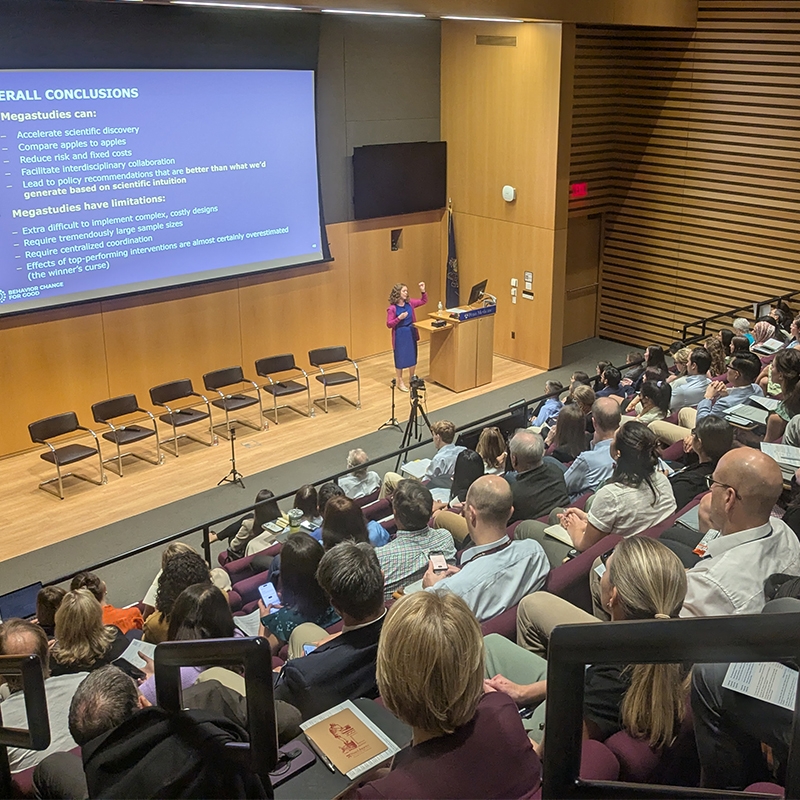Insights from the 2025 Nudges in Health Care Symposium

The seventh annual Nudges in Health Care Symposium brought together more than 200 thought leaders, researchers, and practitioners from across the United States—and six other countries—to explore the evolving landscape of behavioral science in health care. Held September 11 and 12, 2025, at the University of Pennsylvania, this year’s event featured keynotes about learning from megastudies and overcoming performance limitations with artificial intelligence (AI), plus an array of short research presentations, two poster sessions, a panel discussion on AI in clinical decision support, and workshops.
In this recap, we review highlights from the 2025 program. Recordings for parts of the program are available to watch on Vimeo.
The power of megastudies
Day 1 of the symposium, Katherine Milkman, PhD, a professor at the Wharton School of the University of Pennsylvania, introduced the concept of “megastudies”– simultaneous experiments that test multiple behavioral interventions in the same context. Megastudies can address some of the difficulties faced with field experiments, she said, such as cost and speed and the “apples-to-oranges” comparisons that occur when context differs among studies.
Milkman’s research revealed some surprises. One megastudy she co-led, comprising 53 sub-studies aimed at building exercise habits, found that experts were often wrong when it came to forecasting which interventions would be successful. “They may as well be throwing darts at the wall. This is why testing is so important,” she said.
Intuition also failed when it came to vaccine uptake: Contrary to what the researchers thought, providing free rides to a pharmacy did not lead more people getting COVID vaccines. What did improve COVID and flu vaccination rates was using endowment language – for example, that a shot was waiting or reserved for the individual – and sending multiple reminders.
A forum to share experiments and learnings
 Throughout the symposium, speakers shared candid accounts of successes and setbacks. During the “Stories from the Field” sessions, researchers from seven organizations shared how they approached diverse challenges, from increasing flu vaccine uptake and reducing emergency department overuse to cutting patient medication costs.
Throughout the symposium, speakers shared candid accounts of successes and setbacks. During the “Stories from the Field” sessions, researchers from seven organizations shared how they approached diverse challenges, from increasing flu vaccine uptake and reducing emergency department overuse to cutting patient medication costs.
Christopher Chabris, PhD, of Geisinger, reported that algorithmically selected nudges tailored to patient characteristics did not significantly outperform endowment messages like those in Milkman’s megastudy. He concluded that scalable, cost-effective behavioral nudges may be preferable in large health systems, and more rigorous evaluation of AI-driven messaging is needed.
Two Penn researchers shared examples of successful electronic health record (EHR) nudges used for breast cancer screening. Supplemental MRI screening is recommended for women with extremely dense breasts; Anne Marie McCarthy, ScM, PhD, and her team found that MRI ordering increased 80 percent with clinician-directed nudges. Kim Waddell, PhD, MSCI, discussed a trial showing that multi-component EHR nudges, including a pended order, significantly increased the odds of mammogram completion.
On the flip side, Zahera Farhan, MPH, of the University of Michigan, shared that while EHR-based alerts for heart failure medications seemed promising, 80 percent were ignored or suppressed. Human-delivered nudges were the most effective intervention that her group tested. Hayley Belli, PhD, of NYU Grossman School of Medicine, whose team found that EHR-based nudges plus monthly emails to clinicians did not improve patient compliance with diabetes management medication guidelines, posited that clinician engagement is required to deliver nudges at the right place and time.
 Evolving approaches to AI
Evolving approaches to AI
Adam Rodman, MD, MPH, of Harvard Beth Israel Deaconess Medical Center, delivered a provocative keynote on AI in health care. He challenged the prevailing “human-in-the-loop” model, arguing that it leads to cognitive deskilling, inefficiency, and limited scalability. The better alternative, Rodman claimed, is a “human-on-the-loop” approach, where AI operates autonomously within defined boundaries while humans have oversight.
Successfully integrating human-on-the-loop AI faces some hurdles, such as a lack of regulatory frameworks and unclear payment models, so Rodman advocated for thoughtfulness in the path ahead. “The tech is powerful,” he reminded the audience, “but not magic.”
After Rodman’s lecture, an expert panel moderated by Srinath Adusumalli, MD, MSHP, MBMI, of Penn Medicine, explored how to integrate AI into clinical decision support and EHR nudges. Carissa Kathuria, of Epic, advocated for design research including user testing and immersion. She recommended communicating the “why” behind AI-driven recommendations, something which Craig Joseph, MD, of Nordic Global, echoed, saying it helped overcome resistance to adoption. However, Rodman, also on the panel, suggested that although clinicians appreciate transparency, it doesn’t necessarily improve performance.
Kendrick Cato, PhD, RN, of the University of Pennsylvania, pointed to the need for a culture of feedback to understand how AI is being used and the outcomes. He raised concerns about equity, in terms of access to the technology, and highlighted opportunities with AI that could improve care, like by modeling and amplifying nurse intuition-informed behavior and by surfacing biases in the practice of medicine.
With the rapid advances in AI-driven industry, the panelists advised health systems focus on impact over action – that is, using AI strategically and not reactively. They offered strategies like creating dedicated executive roles focused on human-centered AI integration, grounding decision-making in the experience of frontline workers, educating senior leaders, and being intentional with change management.
For a deeper dive into Adam Rodman’s keynote and more photos from the 2025 symposium, please view the Penn LDI blog post “In the loop or on the loop: the conundrum of AI clinical decision support.”
Visit the Nudges in Health Care Symposium web page to learn more about this annual event and view content from previous symposia.